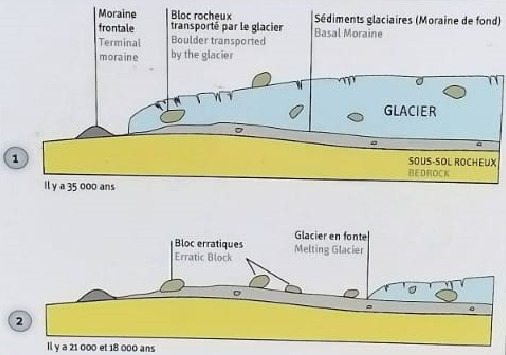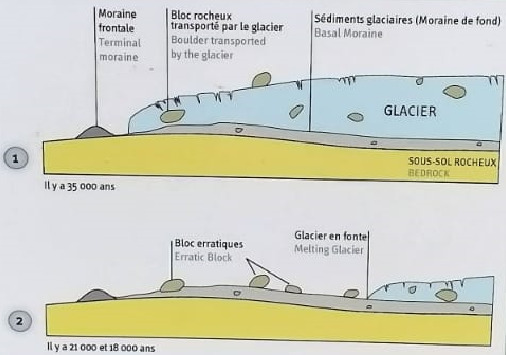
Rappel concernant les « Earthcaches »: Il n'y a pas de conteneur à rechercher ni de logbook à renseigner. Il suffit de se rendre sur les lieux.
Présentation
Au bord du lac Léman, l'adorable village médiéval d'Yvoire est une étape incontournable. Remparts, portes fortifiées et donjon du château du XIVe siècle protègent les charmantes rues fleuries.
Sur le Lac, veille une vieille pierre, la « Pierre d’Equarre »
Il s’agit d’un bloc erratique
Bloc erratique
Un bloc erratique est, en géologie et en géomorphologie, un fragment de roche d'origine morainique qui a été déplacé par un glacier parfois sur de grandes distances. Lors de la fonte du glacier, le bloc erratique est abandonné sur place.
Le calibre des matériaux erratiques va des petits cailloux jusqu'aux gros blocs de plusieurs milliers de tonnes. Mais on réserve le terme de bloc erratique aux fragments rocheux de gros calibres. Les matériaux de plus petits calibres forment quant à eux des moraines, des sandurs, des drumlins…
Les géologues peuvent retrouver le lieu d'origine d'un bloc erratique en effectuant des analyses pétrographiques. On démontre ainsi que des blocs peuvent être transportés sur des milliers de kilomètres.
On retrouve des blocs erratiques partout où il y a eu des glaciers.
La "pierre d'Equarre"
Il y a 35 000 ans le bassin lémanique était entièrement comblé par le glacier du Rhône.
Au niveau d'Yvoire l'épaisseur de la glace atteignait alors au maximum 1100 mètres.
Le glacier emporté avec lui de nombreux débris de roches tombés à la surface lors de son déplacement.
Au moment de sa fonte les blocs rocheux sont abandonnés sur place et prennent le nom de bloc erratique (littéralement "des blocs qui errent")

Questions pour valider cette Earthcache :
Question 1 : Décrivez ce que vous voyez depuis votre point d'observation... (la forme, l’aspect, la couleur,...)
Questions 2 : Comment expliquez-vous que le bloc de composition similaire aux blocs situés à l'est du Lac en Suisse soit arrivé ici ?
Question 3 : Quelle technique est utilisée par les géologues dans l'étude de l'origine des pierres ?
Question 4 : Quel est littéralement le sens des termes " bloc Erratique "
- Une photo de vous ou d’un objet vous représentant sur le site.
Loguez cette cache "Found it" et envoyez-moi vos propositions de réponses soit via mon profil, soit via la messagerie geocaching.com (Message Center), et je vous contacterai en cas de problème. Les logs enregistrés sans réponses seront supprimés.
Bon geocaching !

Reminder on "Earthcaches" There is no container or logbook to find information. Simply visit the site.
Presentation
On the shores of Lake Leman, the adorable medieval village of Yvoire is an essential stopover.
Ramparts, fortified gates and keep of the 14th century castle protect the charming flower-lined streets.
On the lake, an old stone stands watch, the “Equarre Stone”
It is an erratic block
Erratic block
An erratic block is, in geology and geomorphology, a fragment of rock of moraine origin which has been moved by a glacier, sometimes over great distances. When the glacier melts, the erratic block is left in place.
The caliber of erratic materials ranges from small pebbles to large blocks weighing several thousand tons. But the term erratic block is reserved for large-caliber rock fragments. Materials of smaller calibers form moraines, sandurs, drumlins, etc.
Geologists can trace the origin of an erratic block by carrying out petrographic analyses. This demonstrates that blocks can be transported over thousands of kilometres.
Erratic blocks are found wherever there have been glaciers
« Equarre stone"
Looking back 35,000 years, the Lake Leman basin was completely filled by the Rhône glacier.
The ice reached a maximum thickness of 1100 m above YVOIRE
The glacier carried with it many rocky block that fell to the surface during its movement.
At the time of its melting the rocky blocks are abandoned on the spot. Their long voyage has earnt them their name of « erratic blocks (literally the wandering stones)

Questions to validate this Earthcache:
Question 1: Describe what you see from your vantage point... (shape, appearance, color,...)
Question 2: How do you explain that the block of composition similar to the blocks located east of the lake in Switzerland arrived here?
Question 3: What technique is used by geologists in the study of the origin of stones?
Question 4: What is literally the meaning of the terms "Erratic block"
- A photo of you or of an object representing you on the site.
Log this "Found it" cache and send me your suggested answers either via my profile or via geocaching.com (Message Center), and I will contact you in the event of a problem. Logs recorded without response will be deleted.
Good geocaching !